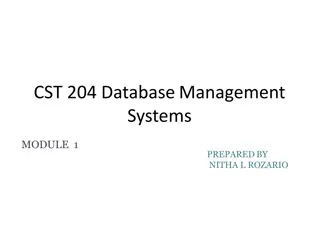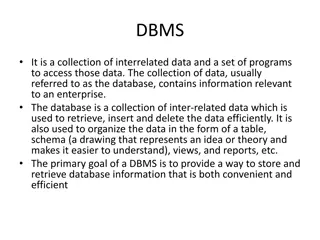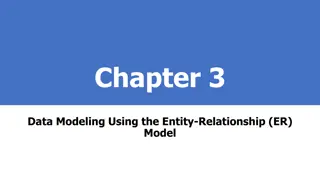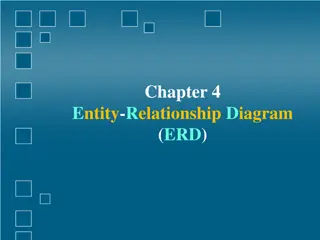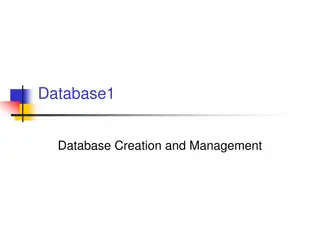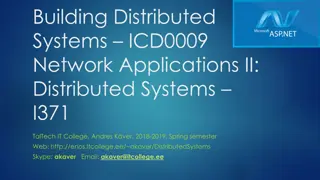Efficient Entity Framework Operations for Database Management
Learn how to efficiently manage data in Entity Framework by adding, updating, and deleting entities with ease. Discover how to perform multiple operations in a single transaction, handle related data effectively, and optimize database interactions.
Download Presentation

Please find below an Image/Link to download the presentation.
The content on the website is provided AS IS for your information and personal use only. It may not be sold, licensed, or shared on other websites without obtaining consent from the author.If you encounter any issues during the download, it is possible that the publisher has removed the file from their server.
You are allowed to download the files provided on this website for personal or commercial use, subject to the condition that they are used lawfully. All files are the property of their respective owners.
The content on the website is provided AS IS for your information and personal use only. It may not be sold, licensed, or shared on other websites without obtaining consent from the author.
E N D
Presentation Transcript
Building Distributed Systems ICD0009 Network Applications II: Distributed Systems I371 TalTech IT College, Andres K ver, 2018-2019, Spring semester Web: http://enos.Itcollege.ee/~akaver/DistributedSystems Skype: akaver Email: akaver@itcollege.ee
EF - Saving data 1 Add Data Use the DbSet.Add method to add new instances of your entity classes. The data will be inserted in the database when you call SaveChanges. The Add, Attach, and Update methods all work on the full graph of entities passed to them, as described in the Related Data section. Alternately, the EntityEntry.State property can be used to set the state of just a single entity. For example, context.Entry(blog).State = EntityState.Modified.
EF Updating data 2 EF will automatically detect changes made to an existing entity that is tracked by the context. This includes entities that you load/query from the database, and entities that were previously added and saved to the database. Simply modify the values assigned to properties and then call SaveChanges.
EF Deleting data 3 Use the DbSet.Remove method to delete instances of your entity classes. If the entity already exists in the database, it will be deleted during SaveChanges. If the entity has not yet been saved to the database (that is, it is tracked as added) then it will be removed from the context and will no longer be inserted when SaveChanges is called.
EF - Multiple Operations in a single SaveChanges 4 You can combine multiple Add/Update/Remove operations into a single call to SaveChanges. For most database providers, SaveChanges is transactional (atomic). This means all the operations will either succeed or fail and the operations will never be left partially applied.
EF Related data 5 Adding a graph of new entities. If you create several new related entities, adding one of them to the context will cause the others to be added too If you reference a new entity from the navigation property of an entity that is already tracked by the context, the entity will be discovered and inserted into the database. If you change the navigation property of an entity, the corresponding changes will be made to the foreign key column in the database.
EF Related data 6 Removing relationships You can remove a relationship by setting a reference navigation to null, or removing the related entity from a collection navigation. Removing a relationship can have side effects on the dependent entity, according to the cascade delete behavior configured in the relationship. By default, for required relationships, a cascade delete behavior is configured and the child/dependent entity will be deleted from the database. For optional relationships, cascade delete is not configured by default, but the foreign key property will be set to null.
EF Cascade delete 7 EF Core implements several different delete behaviors and allows for the configuration of the delete behaviors of individual relationships. EF Core also implements conventions that automatically configure useful default delete behaviors for each relationship based on the requiredness of the relationship. There are three actions EF can take when a principal/parent entity is deleted or the relationship to the child is severed: The child/dependent can be deleted The child's foreign key values can be set to null The child remains unchanged
EF - Cascade delete 8 Optional relationships (nullable foreign key) Behavior Name Cascade ClientSetNull (default) SetNull Restrict Effect in memory Entities are deleted Foreign key properties are set to null None Foreign key properties are set to null Foreign key properties are set to null None Effect in DB Entities are deleted None Required relationships (non-nullable FK) Behavior Name Cascade (Default) ClientSetNull SetNull Restrict Effect in memory Entities are deleted SaveChanges throws SaveChanges throws None Effect in DB Entities are deleted None SaveChanges throws None
EF Cascade delete 9 If you have entities that cannot exist without a parent, and you want EF to take care for deleting the children automatically, then use Cascade. Entities that cannot exist without a parent usually make use of required relationships, for which Cascade is the default. If you have entities that may or may not have a parent, and you want EF to take care of nulling out the foreign key for you, then use ClientSetNull Entities that can exist without a parent usually make use of optional relationships, for which ClientSetNull is the default. If you want the database to also try to propagate null values to child foreign keys even when the child entity is not loaded, then use SetNull. However, note that the database must support this, and configuring the database like this can result in other restrictions, which in practice often makes this option impractical. This is why SetNull is not the default. If you don't want EF Core to ever delete an entity automatically or null out the foreign key automatically, then use Restrict. Note that this requires that your code keep child entities and their foreign key values in sync manually otherwise constraint exceptions will be thrown.
EF Cascade delete 10 Remove cascade delete totally (my personal choice) protected override void OnModelCreating(ModelBuilder builder) { base.OnModelCreating(builder); // disable cascade delete foreach (var relationship in builder.Model .GetEntityTypes().SelectMany(e => e.GetForeignKeys())) { relationship.DeleteBehavior = DeleteBehavior.Restrict; } }
EF Cascade Delete 11 Configuring per relationship Data Annotations No Fluent API modelBuilder.Entity<Post>() .HasOne(p => p.Blog) .WithMany(b => b.Posts) .OnDelete(DeleteBehavior.Cascade);
EF - Providers 12 MS providers SqlServer, SQLite, InMemory Cosmos preview Oracle - sample 3rd party PostgreSQL - Npgsql.EntityFrameworkCore.PostgreSQL MySql/MariaDB - Pomelo.EntityFrameworkCore.MySql Oracle - Oracle.ManagedDataAccess.Core, full version in beta MySql/MariaDb Oracle, has problems with Booleans (Boolean is not an datatype in MySql needs conversion)
EF 14



